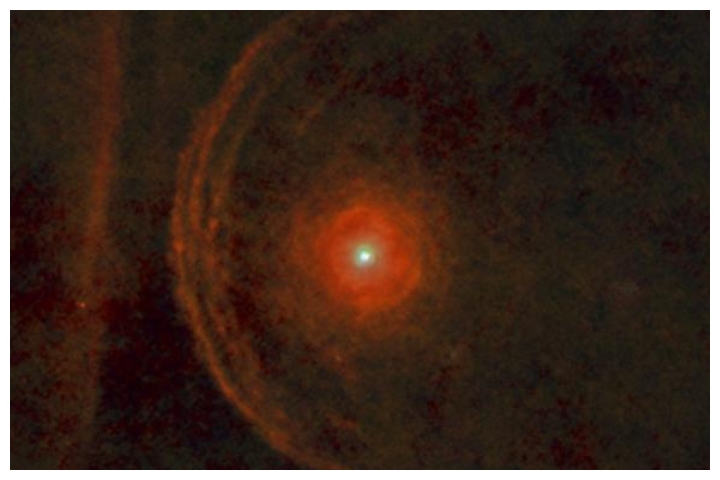Betelgeuse, the normally bright red star in the constellation Orion, might be dying — and its supernova will one day rival the moon in the sky above Earth. One day.

Betelgeuse is currently in its red supergiant phase, which is the geriatric stage of a star’s life when it gets bright and bloated before it dies. The next phase is full-blown supernova, when the star will collapse in on itself in a massive explosion.
The explosion is expected to happen “sometime in the next 100,000 years,” according to NASA. When it does happen, it’s expected to light up the sky over Earth in a spectacular display that will last for weeks.
Many skywatchers are hoping that “sometime” will be “sometime soon” after observing an obvious decline in Betelgeuse’s light over the last several months. Betelgeuse’s brightness faded by more than half in the latter part of 2019, making it dimmer than it’s ever been in recorded history. It’s still visible in the “armpit” of Orion, but it’s not nearly as bright as it used to be.
- U.S. tourist faces 12-year sentence for bringing ammo to Turks and Caicos
- Canada refused to repatriate woman from ISIS camp because she can’t be arrested: internal memo
- Aw, rats: Chicago’s beloved ‘Rat Hole’ removed from sidewalk
- Tabloid publisher tells trial he bought, squashed stories damaging to Trump
NASA says Betelgeuse is “likely” just running through its variable cycles, which make it look brighter or dimmer from time to time. It’s a coughing, cranky old star, and there are bound to be hiccups as it nears the end.

A recent burst of gravitational waves has stoked speculation that the end might be near for Betelgeuse, though astronomer Andy Howell says the two situations are probably not related.
Howell admitted to stepping outside to see if Betelgeuse had blown up Tuesday, although he compared that to “buying a lottery ticket” in terms of the slim chance that it might occur.
“Betelgeuse blowing up would be far more exciting than winning the lottery,” Howell tweeted. “Lottery winners happen every day. It has been 400 years since humans have seen a supernova in our galaxy, and I’m one of the best prepared people on the planet for it.”
Supernova expert J. Craig Wheeler says it’s highly unlikely that Betelgeuse is about to explode.
“My money all along has been that Betelgeuse is going through a somewhat extreme, but otherwise normal quasi-periodic change in brightness,” he told The New York Times from the University of Texas at Austin.
Nevertheless, some skywatchers say they’re ready to start the Betelgeuse death watch. Just in case.
Betelgeuse is approximately 640 light-years from Earth. That means it’s close enough that we could watch it die without a telescope, while being far enough away that it won’t hurt us when it goes, NASA says. And it will absolutely go sometime in the next 100,000 years, in what astronomers say will be a truly spectacular display.
When Betelgeuse blows up, the supernova will be about as bright as a quarter-moon in the Earth’s sky, according to a 2015 article on the subject by Jillian Scudder, a U.K.-based astrophysicist. The supernova would show up clearly in the night sky, and would even be visible during the day if you know where to look.

Scudder said a dying Betelgeuse would be about 16 times brighter than the most well-documented supernova, which caused a stir among many ancient civilizations in 1006.
“It was said that the supernova in 1006 was bright enough to cast a shadow at night,” Scudder wrote. “Betelgeuse, being significantly brighter, would likely also cast shadows.”
One simulation suggests it would look like a bright streetlight hanging in the sky for several weeks before it fades away, leaving one less star in the Orion constellation.
Popular astronomer Neil deGrasse Tyson echoed Scudder’s words in a lengthy Twitter thread about Betegeuse’s death earlier this month.
“No need to panic, but if it exploded, the flash would be visible in the daytime, and rival the brightness of the moon for weeks,” Tyson wrote.
Tyson also pointed out that Betelgeuse “may have already exploded,” since it would take about 640 years for its light to reach Earth. That would make it a ghost or a “dead star walking,” as Tyson put it.
In fact, there might be many “dead stars” in the night sky right now, although we wouldn’t know it for millennia because of how long it takes for light to travel through space.
As writer Alan Moore once put it: “All we ever see of stars are their old photographs.”
And Betelgeuse’s next photograph might be a crazy one — though it might take a few millennia for it to reach us.




Comments